Aquarium Shrimp Gallery
Through building and maintaining beautiful nature aquaria people re-learn the intricate connections between forms of life, plants, fish, microorganism and humans. Riches and beauty come from harmony, from balance. Aquaria are great teachers of this truth. TAKASHI AMANO
11/01/2010
8/02/2007
Atyopsis moluccensis/spinipes sp

 There are two species of Atyopsis Asian species; Atyopsis moluccensis and Atyopsis spinipes.
There are two species of Atyopsis Asian species; Atyopsis moluccensis and Atyopsis spinipes.It is hard to see the difference between these two.
This shrimp grows to approx. 8-10 cm and needs acidic conditions (lower pH levels)
Since it is a filter feeding shrimp it needs a stronger water current to be able to catch microorganinsms/zoo-spores with its chelae, fan like filters. And therefore power-heads should be used to create a good water flow.
Fan shrimp should never be added into newly established set-ups. It prefers aged aquariums with well developed microorganisms this shrimp feed on. If there is enough food (good water current) this shrimp will develop strong red coloration and the back line will develop a gold-yellow color.
Weekly water changes are very important for all shrimps, and one should try to do 30-50% WC, using dechlorinators. Replaced water should have the same temperature as the one in the tank.
It is very good using Active Carbon in shrimp tanks to remove the organic build-up which can harm shrimps.
Sex difference;
Males have a very strong pair of front legs. Females carapace extends down over the pleopods to accommodate the eggs.
Photos (a female) by Dusko Bojic.
3/08/2007
Caridina cf. cantonensis 'Crystal Red'




This is one of the most beautiful dwarf shrimps one can keep in a fresh water aquarium. It needs very acidic, soft water. Alkaline water will harm this shrimp causing it to die premature. Temperature should not exceed 26'Celsius, and should not be lower than 20'Celsius. It is a great algae eating shrimp, that feeds on microorganisms and algae. It is good to introduce whithered oak leaves, since microorganisms/bacteria grows readily on them which this shrimp will eat.
To successfully breed this shrimp water has to be acidic with a low pH. Crystal Red Shrimp grows to about 2.5-3.5 cm. Keep them with small fish since the bigger one will very likely devour them. Water conditioner is a must use, because chloramine/heavy metals are very harmful.
On this photo one can see the shrimps front, picking, legs/hands, harvesting microorganisms/algae/bacteria from the tank glass.
 Shrimps head is packed with all sorts of antennae/feelers.
Shrimps head is packed with all sorts of antennae/feelers. Observations;
Observations;Crystal Red Shrimps live shorter in alkaline waters and not many shrimplets survive. If intending to keep and breed CRS, acidic water conditions are needed for this shrimp to thrive (low pH and KH).
Photos by Dusko Bojic.
9/16/2006
Neocaridina heteropoda var. red/Red Cherry Shrimp
Female Neocaridina heteropoda var. red
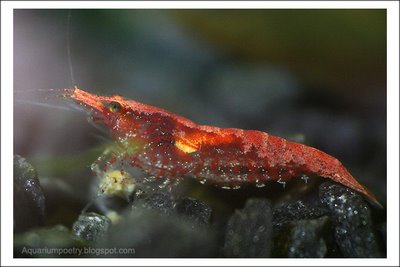 Male Red Cherry shrimp grows smaller (2.5cm) than the female (3.5cm). Males are pale and transparent with very little red/brown, while females are deep red (light red when juvenile).
Male Red Cherry shrimp grows smaller (2.5cm) than the female (3.5cm). Males are pale and transparent with very little red/brown, while females are deep red (light red when juvenile).Females produce approx. 20 eggs (yellow/orange colored) that they carry for about 3-4 weeks On the photo above one can see the yellowish saddle where the eggs form before being dropped onto the pleopods). The hatchlings are fully formed miniature shrimps (link to baby shrimp video). They don't go through larval stages. This shrimp does extremely well in waters in within alkaline pH range and moderate hardness.
 For some reason young females release their first eggs after 1-2 days (photo above), but the next batches are carried till the eggs hatch. Click on the next link to see the shrimplets video;
For some reason young females release their first eggs after 1-2 days (photo above), but the next batches are carried till the eggs hatch. Click on the next link to see the shrimplets video;http://aquavideos.blogspot.com/2006/11/red-cherry-shrimplets.html
Photos and videos by Dusko Bojic
Caridina multidentata aka Amano shrimp
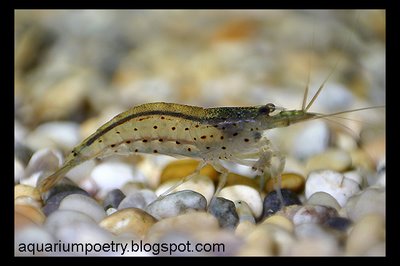 Female Caridina multidentata (previous C. japonica)
Female Caridina multidentata (previous C. japonica) The difference between males and females of C. multidentata are obvious.
The difference between males and females of C. multidentata are obvious. 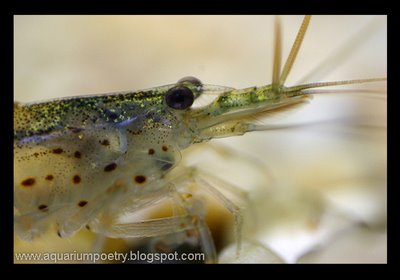
 Like any other crustaceans, C. multidentata changes the exoskeleton every now and then. Juveniles change it every 4 to 7 days while grown ups do it approx. every month or so. Reason for shedding the skin is to accommodate their growing bodies or simply to repare some damaged body parts. How often they will molt depends on temperature (22-27 Celsius is preferred range) and food type, but usualy all shrimps molt after the partial water change.
Like any other crustaceans, C. multidentata changes the exoskeleton every now and then. Juveniles change it every 4 to 7 days while grown ups do it approx. every month or so. Reason for shedding the skin is to accommodate their growing bodies or simply to repare some damaged body parts. How often they will molt depends on temperature (22-27 Celsius is preferred range) and food type, but usualy all shrimps molt after the partial water change.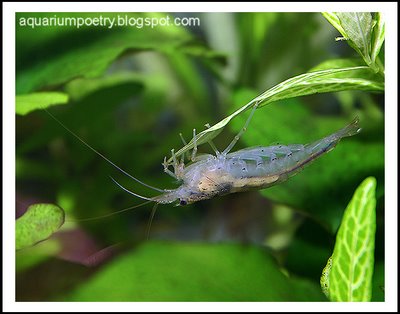 The female starts developing eggs in their ovaries (photo above shows the "white saddle", forming eggs) before the actual fertilisation takes action. When the female feels ready for breeding, she starts releasing pheromones which will attract males. Males will sense it and go after the female. For the reason all males swim around the tank like crazy, some people think that the water quality is worsened, but this is not the case. They are just trying to get to the ready female. The chosen male is allowed to climb under the female and fertilise the eggs. A few days latter the female will drop the eggs (up to 400 eggs) onto the swimmerets/pleopods, where she will carry them for about 4-5 weeks.
The female starts developing eggs in their ovaries (photo above shows the "white saddle", forming eggs) before the actual fertilisation takes action. When the female feels ready for breeding, she starts releasing pheromones which will attract males. Males will sense it and go after the female. For the reason all males swim around the tank like crazy, some people think that the water quality is worsened, but this is not the case. They are just trying to get to the ready female. The chosen male is allowed to climb under the female and fertilise the eggs. A few days latter the female will drop the eggs (up to 400 eggs) onto the swimmerets/pleopods, where she will carry them for about 4-5 weeks.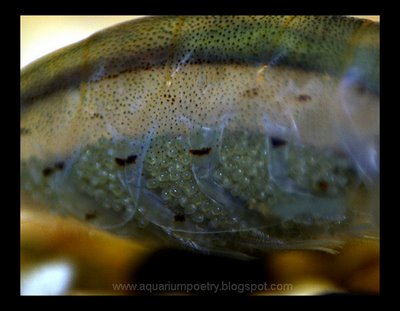 When the eggs form eyes (the photo below), it is known that the hatching is near (next 5-7 days). In my experience the first eggs hatched after about 10-15 days after I noticed the eyes.
When the eggs form eyes (the photo below), it is known that the hatching is near (next 5-7 days). In my experience the first eggs hatched after about 10-15 days after I noticed the eyes. When eggs hatch, the tiny 1-1.5mm larvae is released. The larvae should spend not more than 8 days in freshwater because it will need full marine salinity (35ppt). It will go through few larval stages before it transforms into post-larvae aka the miniature shrimp. The larvae will spend up to 30-60 days in marine water before fully transformed into a miniature shrimp. Then it can be placed in freshwater, where it will thrive for next 3-4 years (life span). It has been known that this shrimp is sexually mature when 6 month old. You can look into my Caridina multidentata breeding attempts Vol.1 and Vol.2 , as well as how important role, bog-wood and Oak leaf litter, plays in this shrimps diet (they eat the microorganisms, fungus and algae growing on the wood and leaves).
When eggs hatch, the tiny 1-1.5mm larvae is released. The larvae should spend not more than 8 days in freshwater because it will need full marine salinity (35ppt). It will go through few larval stages before it transforms into post-larvae aka the miniature shrimp. The larvae will spend up to 30-60 days in marine water before fully transformed into a miniature shrimp. Then it can be placed in freshwater, where it will thrive for next 3-4 years (life span). It has been known that this shrimp is sexually mature when 6 month old. You can look into my Caridina multidentata breeding attempts Vol.1 and Vol.2 , as well as how important role, bog-wood and Oak leaf litter, plays in this shrimps diet (they eat the microorganisms, fungus and algae growing on the wood and leaves).
Photos and text by Dusko Bojic.
